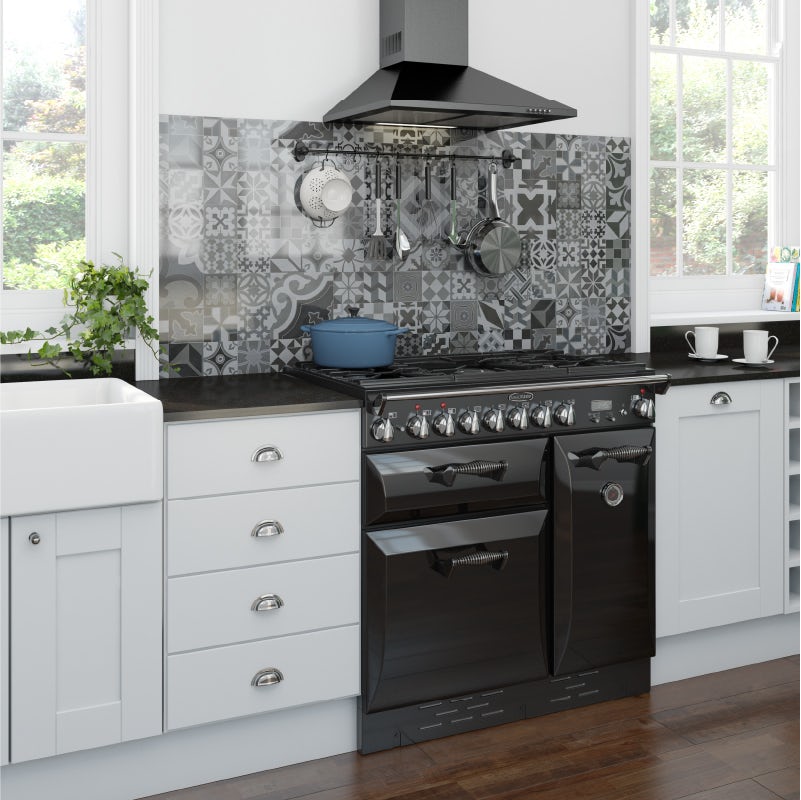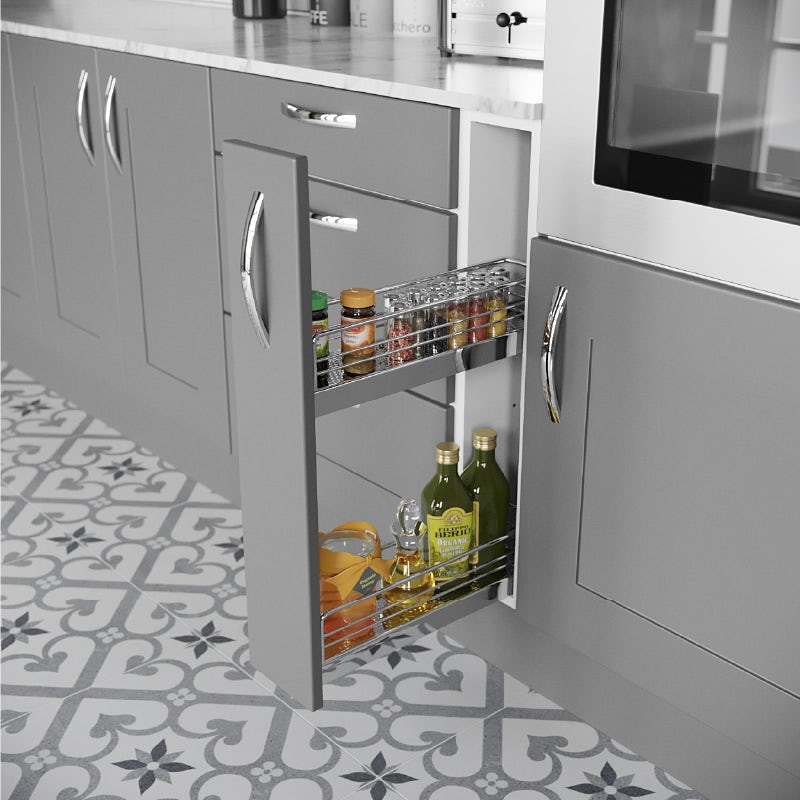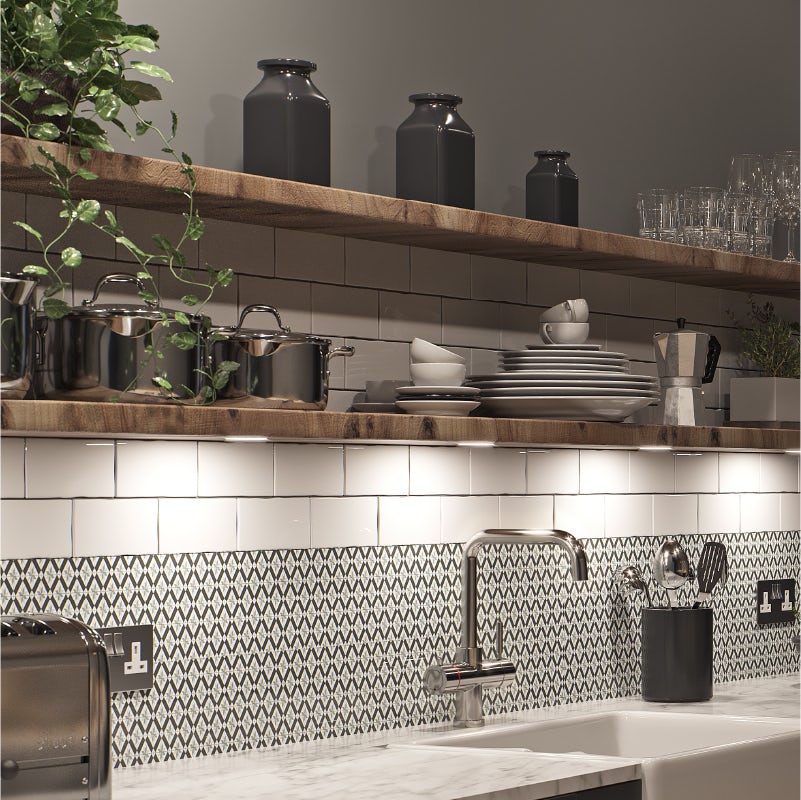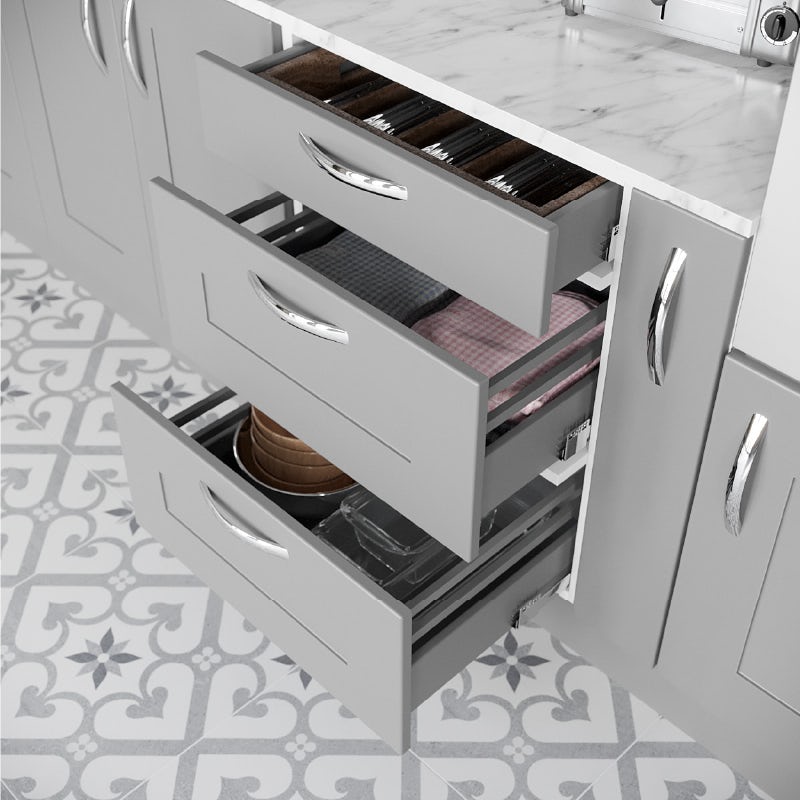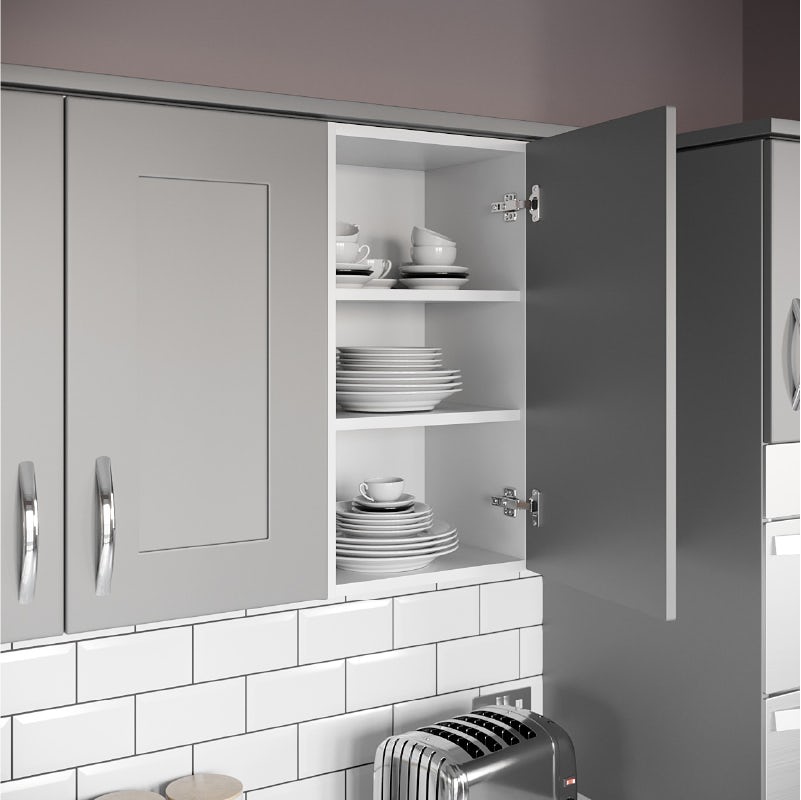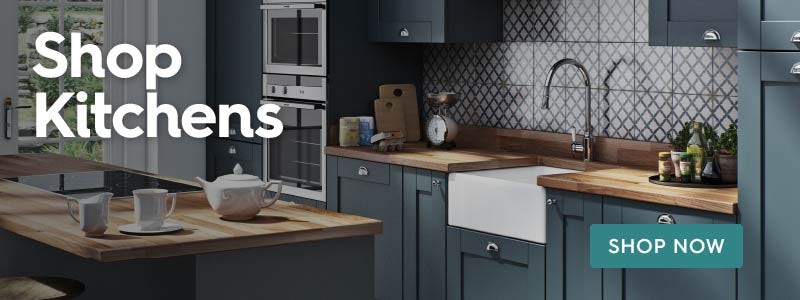Does your kitchen space make you feel stressed? Are your cupboards crammed and countertops crowded? Help is at hand…
Keeping on top of everything at home can be difficult, especially with work and family commitments. Whilst we tend to focus on keeping our bedrooms and living rooms tidy, clutter can build up in our kitchens, making them feel more stressful than they should be.
But fear not…there are plenty of ways you can wrestle back control, by decluttering the cabinets and shelves in your kitchen. We’ve put together some helpful kitchen cabinet organisation ideas to provide you with lots of great tips on how to organise everything from your cooking ingredients to your pots, pans and plates.
How do you decide where to put things in kitchen cabinets?
When designing and installing a home kitchen, the idea is to make sure everything can be used with efficiency. This is why most kitchens feature something called “the kitchen triangle”, which ensures the cooker, fridge and sink are in close proximity to each other and, usually, in a triangular layout—hence the name!
The same basic principles apply when it comes to figuring out the best way to organise kitchen cabinets. Ideally, you’ll need everything in a logical order, so the items you use every time you cook or prepare a meal are easily accessible.
For example, you may want your spice drawer immediately to hand, so you can get to the salt, pepper, herbs and other important ingredients that need to be added whilst cooking. Items like cleaning supplies usually go under the sink (although, if you have a separate laundry or utility room, they will usually be stored there) and a drying rack will go next to the sink. However, if you have small children (or even inquisitive pets) in your household, potentially harmful cleaning supplies should ALWAYS be kept out of reach.
Make sure you have the items you use the most in cabinets closest to the cooker, so you can simply reach in and grab them without having to move too far.
What are the 10 steps for organising kitchen cabinets?
Step 1: Take everything out of the cupboard
The first step on the road towards kitchen cabinet organisation is to take everything out and place it on the worktop. Once you take everything out of your cabinets, you’ll probably wonder who it can all ever fit back inside! It’ll invariably make your kitchen look messy for a short period, but it’s always best to start with a blank canvas. You’ll likely discover several items and products that have been forgotten about and are either no longer used or out of date. Get rid of whatever you can to reduce the number of items that need to go back into your kitchen cupboards.
Step 2: Tuck away little-used ingredients
There will be items that you don’t use very often, if it all…although, you won’t want to throw these away. A good tip is to put these inside a small box which can be placed inside your cabinets, so they are all together in one handy place (wrap them well, as you won’t want pungent smells to overpower other food items).
If they don’t already have labels, add some yourself. That way, you’ll know exactly what is in each container—an easy yet often-overlooked tip for when you eventually reach for your box of lesser-used ingredients.
The video below shows you how to add reusable labels to bathroom accessories, but can easily be applied to kitchen containers.
Step 3: Use top shelves for baking supplies
You may love to whip up a wonderful pie or cake on occasion, but, unless you’re Mary Berry, it’s unlikely you have the time to make one every week. Some baking products can be quite chunky and take up a lot of space inside your cabinets, so it makes sense to put these items on the top shelves which tend to be the least used in cupboard. You can then enjoy easy access and space in the shelves below.
Step 4: Add bottles to the lazy Susan
Despite the slightly derogatory nickname, a lazy Susan turntable is a clever space-saving device that can help declutter and organise your kitchen cupboard. It’s best used on bottom shelves for easy access to everyday spices (as an alternative to a countertop spice rack), and bottles you regularly use like cooking wines or oils. This will make optimum use of the space available inside. When adding a lazy Susan to cabinets, push it to the left so you can make space on the right-hand side, where things like salt and pepper can be placed.
Step 5: Organise by colour
If you are more of a visual person, it may be a good idea to organise your cupboard items by colour. For example, why not put all the green spices like oregano, mixed herbs and coriander, together? Alternatively, you may be the sort of person that thinks in terms of dishes first, especially if you cook them on a regular basis, so you may want to group together relevant ingredients so they are easy to access.
Step 6: Get rid of shelf organisers
Adding a shelf organiser to your kitchen cabinets may seem like a good idea but in reality, they simply don’t work. Not only do they increase the amount of cleaning that has to be carried out inside your cabinets, but they also tend to get blocked out by other items, defeating the whole purpose of them being there in the first place. Keep it simple with a lazy Susan that can be rotated, food storage containers or even a shoe box that groups everything together.
Step 7: Stack up cans
Ideally, when you open your cupboard or cabinet doors, you’ll want to see exactly what is inside at a glance, rather than having to rummage through and potentially make a mess or knock things over. Cans can be easily lost at the back of a cupboard space, so it helps if you stack them on top of each other. This applies to any type of can, from small tins of tuna to more standard-sized baked bean containers. This will help keep things accessible and makes the most of the food storage spaces you have available.
Step 8: Adjust the height of your shelves
It’s sometimes easy to forget that you can adjust the height of most shelves that come with kitchen cabinets (although some do exclusively have fixed brackets). This might be something to do once you’ve figured out which items and products are going onto particular shelves. Size up your largest item (or double-stacked cans) to see what the correct height of your shelves should be.
Step 9: Use small pocket organisers
While the larger items can be positioned and stacked quite neatly in their right place, it’s often the small items that can make your kitchen cabinet space look messy. Hanging a pocket storage organiser from the back of cupboard door can help here, giving you a place to put items like hot chocolate sachets, tomato puree tubes or small food packets. Allow some space at the front of your shelf for when cabinet doors like this are closed—it’s a really neat little way of maximising cabinet space.
Step 10: Use a plate rack
We’ll go into a bit more detail below about what to do with your plates, pots and pans, but some people like to place their crockery right next to the cooker in nearby cabinets. You can free up space on your shelves for cooking ingredients by installing a plate rack on the wall.
How does Marie Kondo organise kitchen cabinets?
When it comes to organising your kitchen cabinets—and your kitchen in general—there aren’t many better versed than Japanese tidying expert, Marie Kondo (also known as Konmari). She has sold millions of books on the subject, with the focus being more on what you can keep rather than what you need to throw away. Below we reveal some of her best tips and talk about how to use the “Konmari Method” for your kitchen.
Put hand and dish soaps into pump bottles without any labels
Marie’s thinking here is to help make the kitchen a calmer, more serene space to use (kitchens can become quite stressful with all the noise, heat and the pressure of making a nice meal—especially if children are running around your feet). Removing the labels reduces the “visual noise” in the space, to create a cleaner and simplistic area to work in.
Keep your worktops free of clutter
When we say free of clutter, this actually means completely empty. Marie advises not to put anything around the cooker or the kitchen sink area at all, leaving it open. For many, this may seem like an extreme idea, as most people are used to items being positioned around worktops in the kitchen. The idea is based on the age-old phrase “out of sight, out of mind”. For example, if you want to eat less bread, keeping the toaster stored away until you need it will certainly help. Also, juicers are less likely to be used in the winter, so it makes sense to put things like this away. It will make the space look much cleaner and more open. Of course, with a small kitchen you may not have much choice, but it pays to declutter wherever possible.
Cut down on dishes
If you’re like me, you’ll no doubt have built up a rather large collection of dinner plates and bowls over time. These are the ones you use on an everyday basis, with the special dishes you reserve for dinner guests gathering dust, rather than being used to serve food! The best dishes you own are the ones you use every day, so focus on these instead.
When you organise your kitchen cabinets, consider the size of the plates and glasses you use. Some studies have shown that we eat less when using a smaller plate and drink more when we have a larger glass. You don’t have to go this far but some people even switch to paper plates to save on space (although constantly buying paper plates can be expensive and certainly isn’t great for the environment).
Think about ease of cleaning
A messy or dirty kitchen makes it more difficult to cook, so good kitchen cupboard organisation should take ease of cleaning into account. Keep worktops clear and store away utensils and ingredients in kitchen cupboards and drawers—cleaning then becomes much easier. When you’ve finished cooking or preparing a meal, simply wipe down the surface to get rid of any water or spillages that may have occurred.
Store cutlery in upright tubes
Only the lucky few get to enjoy a large, roomy kitchen, which makes kitchen storage space even more valuable. One way to maximise space could be to store cutlery upright in tubes in the same area as your crockery. Or, if you have enough room in your drawers, use dividers as normal, making sure they are shallow and not too bulky.
Categorise your cutlery
This may seem like an obvious one, but you would be surprised at how many kitchen drawers are completely disorganised. Keep forks with forks, knives with knives, etc. It’s the small things that can make a big difference in how much control you have in the kitchen. Try to avoid creating a messy pile inside the drawer, so you can quickly open it, grab what you need, and get on with other tasks.
Consolidate your consumables
Bring together all your various consumable items like tin foil, freezer bags and Clingfilm; put them all into one container or drawer. Quite often, these can be spread out across the kitchen in different locations, but keeping them all in one place makes things more organised and easier to access, especially if you are in a rush and have a small kitchen where you don’t want to keep moving around too much.
Get rid of anything you no longer use
Just like any other part of the home, over time there will be items that fall by the wayside and gather dust as they are no longer used. After a while, they simply get in the way, serving no real purpose as they are moved from one spot to another. Take the brave leap and get rid of cooking appliances and other items taking up too much space that you no longer use. And the items you still occasionally use? Put them away in a cupboard to make more room on your worktops.
Use the Konmari method to fold dish towels
Marie Kondo has a particular method of folding kitchen linen that can help save on space and make things look a little tidier. Follow the steps below:
- Take the long side of the towel and fold it lengthways, to make it look like a long rectangle.
- Fold the rectangle in half (so you are folding it the short way).
- Then fold the towel down further into thirds.
- Now, it’s time to take the “stand test”. This means if it cannot stand up on its own when rested on the worktop, then it hasn’t been folded correctly.
- Once it can stand up on its own, start to fold all the other towels in the same way.
- You can then stand all the linen together in a drawer or basket to create a tidy and easily accessible kitchen storage space for your towels.
Of course, we appreciate that this sort of method is likely to work best in kitchens that have enough space to accommodate a separate drawer just for towels, as storage space is not always so easy to find in more compact kitchens.
Aim for simplicity
The ultimate goal here is to aim for as much simplicity as possible in your kitchen. The kitchen tends to be the one room in the home that continues to collect items, no matter how times you try to weed things out. That’s because it’s such a frequently used room that it’s impossible for us not to bring other parts of our lives into the room with us. But using the Konmari method will hopefully set a template for keeping your space clear, tidy and, most importantly of all, calm and peaceful enough for you to cook up a storm.
Cleaning your cabinets
One thing you should never forget is to clean the inside of your cabinets once you have taken all the items out. In almost every home, these spaces can often be neglected when filled to the brim with food products and other cooking items, so give everything a good spray and wipe down from top to bottom, drying the shelves once you are finished. You will probably also have to wipe down the worktop once you have put everything back, as there may be a few spillages from moving things around the room.
Can you rearrange your kitchen cabinets?
From pots, pans and chopping boards, to measuring jugs and baking sheets, once we have all the utensils needed to cook, things can start to get a little messy in your kitchen cabinets. Previously, we covered how to organise kitchen cupboards for food, utensils and even dish towels, but what about the other large cooking utensils stored in kitchen cabinets? We go into more detail about that below with some helpful tips.
Hang pots them from hooks
This is a simple trick that used to be more common in traditional style kitchens, with pots and pans placed onto hooks which are in turn fitted to a simple piece of wood hanging from the ceiling. The beauty of this design means no more rummaging around on your hands and knees, searching for the perfect pot. Simply reach above your head to unhook the one you need. Plus, with the pots and pans stored elsewhere, it frees up more space in your kitchen cupboards.
Use a pot rack
Pot racks (also known as wire racks) are helpful little tools that allow you to stack up your pots (or frying pans) so they can be easily slid in and out when you need them. If you have a large kitchen, you can put one on top of your work counter, or in a smaller space inside your kitchen cabinets. Simply reach in and grab the pot you want—no messing around or fighting your way through countless other items.
Install a tension rod
It’s not just the pots and pans that get messy and disorganised in kitchen cabinets. One of the biggest bugbears in any cabinet space is dealing with lids. While you may be able to stack the pots in a neat pile inside each other, the lids start to fall all over the place and make the space look untidy. If you put pots and pans into one of your large kitchen drawers, adding a tension rod near the front can help. Simply slot the lids between the rod and drawer to keep them organised, easy to find and out of harm’s way.
Buy some dividers
Another one of our top tips. if you store pots or pans inside a drawer, is to use some dividers. This won’t work so well inside kitchen cupboards or a kitchen cabinet space, but organising using thin pieces of plywood to create individual sections will keep everything separated and looking much more organised and accessible.
Hang a lid rack on cupboard doors
We’ve already discussed how inconvenient lids can be, getting in the way and generally creating a mess in cabinets with pots and pans. Installing a lid rack could be an option that works for you. These are widely available and can be placed on one or more cabinet doors, allowing you to create a little more order inside the other cupboards.
Like this article?
If this blog post has helped you keep your kitchen tidier and better-organised, why not check out the rest of our handy kitchen tips? You’ll find plenty of practical advice including DIY and buying guides for different elements in your kitchen.
In need of some inspiration? Check out all our beautiful kitchen ideas and create the perfect, stylish space for your needs.
Shop kitchens
If your kitchen is still pretty cramped and cluttered, perhaps you need to go one step further and renovate? New units and worktops could help you use space more efficiently, adding value to your kitchen space. Why not browse our comprehensive kitchen selection today by clicking on the image below.

